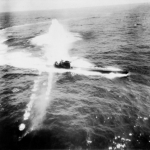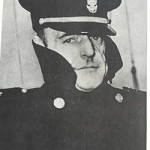In 1938, German Chancellor Adolf Hitler approved a grand blueprint for building a German navy capable of challenging Great Britain’s dominance of the high seas. The ambitious “Plan Z” was due to be completed in 1948, but it had to be abandoned when Hitler invaded Poland on Sept. 1, 1939.
The German U-boat fleet commander, Karl Doenitz, had hoped to have some 300 attack submarines before going to war with the British. Instead, he had a fleet of 65 boats, only 21 of which were ocean-going attack U-boats. The design of these boats had been distilled from World War I submarines and reworked in secret by German engineers in the Netherlands.
The result was an agile, 600-ton U-boat, known as the Type VII. Its twin diesel engines could push the boat to a maximum speed of 17 knots while on the surface, but when the boat was submerged, its two battery-powered electric motors could make only half that speed. The boat was armed with four torpedo tubes in the bow and one in the stern. Including reloads, these initial U-boats carried 11 torpedoes. An 88-millimeter (mm) cannon was mounted on the deck in front of the boat’s conning tower, and a 20mm anti-aircraft gun was typically located on the deck behind the tower or, later, on the rear of the conning tower bridge itself. The submarine had become a formidable weapon of war.
The initial design, a Type VIIA, could operate underwater for about 48 hours before having to surface to recharge the batteries and provide welcome fresh air for the 40-man crew. As a result, U-boats, despite their name, spent most of their time on the ocean’s surface. By the end of the war Germany would build more than 1,100 U-boats, 709 of which were Type VII variants.
When England declared war on Germany, Sept. 3, 1939, Doenitz had already dispatched 19 U-boats in his ocean-going fleet to stations north and south of the sea lanes into the British Isles. The primary target for Germany’s navy was merchant shipping, as the Nazis sought to deny the raw materials and food supplies so vital to the British economy. U-boats sank several merchant ships, including a passenger liner, during the first days of the war. The damage prompted the British Admiralty to quickly adopt the convoy system it had employed in the previous war.
In the lead-up to World War II, Germany had focused most of its naval resources on “capital ships,” the battleships and heavy cruisers by which modern navies measured their prestige. Within a year, however, most of Germany’s capital ships had been neutralized by the larger British Royal Navy. This left the U-boat as the Nazi’s principal naval weapon, and it would prove more than equal to the task, as we will see in our next blog.






